A pallet is a portable platform, with or without super-structure, for the assembly of a quantity of goods to form a unit load for handling and storage by mechanical means. They are widely used for the storage and transit of goods. A reversible pallet is a pallet with similar top and bottom decks, either of which would take the same load. They are not suitable for use with hand-pallet trucks, as the small wheels on the forks will cause damage and separation of the bottom deck.
A wing pallet is a flat pallet whose deck (or decks) project beyond the outer bearers to facilitate the use of lifting slings. They are not suitable for drive-in or drive-through racking where the dimension between racking beam rails has to match the overall width of the pallet, as the wings are not strong enough to support substantial loads.
Flat pallets, post pallets and box pallets are the most common types of pallets used in warehouses. A cage pallet is a special design of pallet that has a superstructure of four attached collapsible vertical sides, usually slotted or mesh. Such pallets are designed to permit stacking by mechanical means. They can be used both for transit of goods and as a display and selection unit for merchandising in retail outlets, ie goods can be put on sale without further unpacking and handling.
Pallets can be constructed from a number of materials, such as steel, plastic or timber. Flat pallets are usually constructed of timber. Pallets should be of sound construction, sound material and of adequate strength.
Using flat pallets
Flat timber pallets form an essential part of many mechanical handling systems in warehouses. Accidents directly attributable to these pallets usually arise from six main sources:
- poor design;
- poor construction;
- the use of a pallet which is unsuitable for a particular load;
- the continued use of a damaged pallet;
- bad handling; or
- the use of a pallet which is unsuitable for a particular racking system
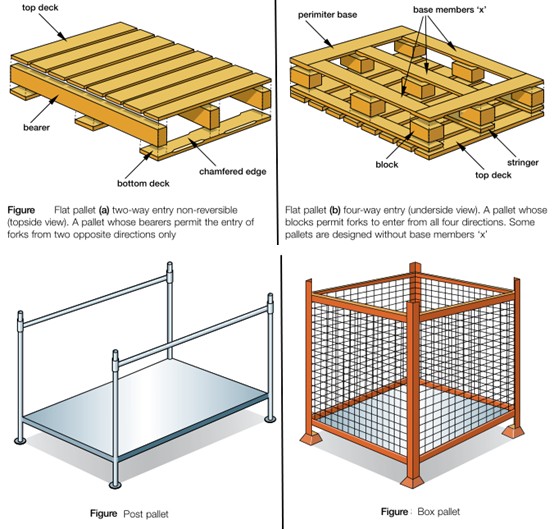
The majority of pallets are designed for carriage of a particular class or type of goods and to be handled or stored by a particular method, eg a pallet intended for the carriage of boxed cereals, handled by a lift truck and stored singly in racking, will not usually be suitable for goods such as cans of paint, lifting by bar sling or for stacking four high. A pallet designed specifically to carry evenly distributed loads, such as boxed cereals, may not be strong enough to carry concentrated loads, such as an electric motor of the same weight.
Where mixed racking systems are installed within a single warehouse, the use of pallets which require a different orientation for each racking system, eg a four-way entry pallet without base members ‘x’, are not be regarded as suitable. Use a pallet design that is suitable for all your racking systems, regardless of orientation.
Loading pallets
Pallets should be loaded to an established pattern designed to achieve maximum stability and safety within the rated load. Loads should be applied gradually, and unless the pallet has been specifically designed for point loading, should, as far as possible, be uniformly distributed over the deck area. As a general guide, the load height should not exceed the longest base dimension of the pallet. Shrink or stretch wrapping the load usually provides greater security, minimising the possibility of movement of goods – it may be possible, in certain circumstances, to safely transport loads taller than the largest base dimension of the pallet.
Stacking palletised loads (block stacking)
Avoid stacking palletised loads of cartons and packs that are capable of being crushed, as the strength and stability of the stack cannot be maintained. Loads that are capable of being stacked directly on top of each other should be positioned on a firm level base. It may be necessary to provide additional packing on top of the lower palletised load, depending on the characteristics of the load and design of the pallet.
Generally, such stacks should not be more than a 4:1 ratio between height of stack and the minimum depth/width of pallet. Four loads high might also be considered a maximum due to the potential problem of crushing the goods on the bottom pallet. In some circumstances, dependent on the height, strength and stability of the loads, taller stacks may be built. The maximum permissible height may be up to six loads high, provided that the pallet itself and the packaging of the stored goods are designed to exceed the four-high strength.
Maintain adequate clearance between rows to ensure safe stacking and withdrawal. Check stacks periodically for stability and take corrective action where necessary.
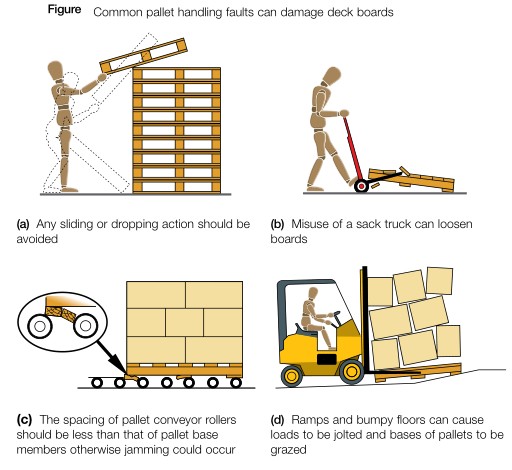
Safe pallet use
Consider the following for safe use of pallets:
- Regular pallet inspection. Damaged pallets should be removed from use.
- Empty pallets should be carefully handled(by methods likely to loosen deck boards) and not dragged or thrown about. Wedging the platform of a sack barrow between top and bottom deck boards can cause damage.
- Hand-pallet truck forks of unsuitable length can cause baseboard damage and be dangerous to workers.
- If hand-pallet trucks are used, take care to ensure that the small finger wheels (also known as trail or guide wheels) do not damage the base boards. Chamfered edges to the bottom deck boards will assist entry of the pallet truck fork arms.
- Expendable pallets, ie pallets designed for one delivery only, should be clearly marked to this effect and are not normally suitable for storing on racking. They should not be reused.
- Take care when using strapping to secure loads to pallets, as deck boards can be pulled from the bearers.
- To avoid damage to pallets and to lift palletised loads safely, the forks of a handling device should extend into the pallet to at least 3/4 of the pallet depth.
- The forks should not extend beyond the pallet, as protruding forks could
- make contact with or lift an adjacent load, causing it to overturn or collapse; or find their way underneath a fixed structure (eg racking) during lifting, causing
- overloading of the truck and serious damage to the racking structure.
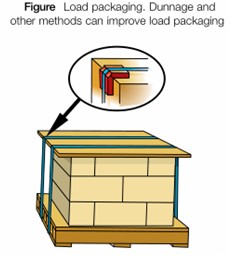
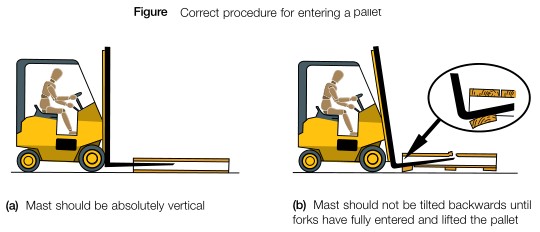
Only authorized, trained and competent people should operate lift trucks Instruct operators on the correct method of handling pallets, emphasizing:
- the mast should be in the vertical position when entering and leaving the pallet, forks should be level with the pallet boards;
- the pallet should be positioned against the heel of the forks;
- the forks should enter the pallet squarely;
- the forks should be correctly spaced for the pallet load being lifted;
- pallets should not be pulled or pushed along the ground;
- loads should be carefully and gently placed on the stack below;
- pallets should be lowered onto racking beams, and never slid across or along the top surface of such beams.
Turntable pallet stretch-wrap machines
These machines are commonly used in warehouse premises to wrap a pallet load in a sheet of plastic film to provide stability, weatherproofing and protection to the load during storage or distribution. The pallet load is usually placed onto the machine turntable using a lift truck or pallet truck; the plastic film is then attached to the pallet load manually, eg by tying to the pallet, and wrapping is carried out by rotating the load on the turntable while the film reel is carried vertically up and down on a column. Some machines are fitted with a top clamp, which descends to steady the pallet load while the wrapping cycle is carried out. Common hazards associated with the use of turntable pallet stretch-wrap machines include,
- trapping a person’s body between the moving pallet load and the fixed structure
- trapping a person’s body between the moving pallet load and fixed parts of the machine
- trapping a hand by moving parts, eg drive mechanisms, chain, and sprockets
- trapping a foot between the power-driven turntable and its surround
- trapping a foot between the underside of the film reel carriage and floor or its framework of the machine
- trapping a hand or arm between the top clamp and the load
In some specialised warehousing situations, pallet wrappers or strappers that are conveyor-fed and operate automatically (including those where the pallet remains stationary while the reel passes round it on a rotating arm) may be found. Such machines generally require a higher standard of guarding, and as a minimum, should be provided within interlocked enclosures.
Pallet inverters
These mechanically operated machines are designed so that a defective pallet at the bottom of a palletised load can be easily removed and replaced with a sound pallet, without the need to de-stack the load by hand. They may also be used to change from one type of pallet to another. Pallet inverters should only be used where a pallet carries non-crushable materials stacked in a manner that allows inversion. The basic operation is as follows:
- Palletised load with defective pallet placed onto the machine platform by lift truck or pallet truck.
- Load clamped between platform and top plate.
- Load inverted by machine.
- Clamping mechanism released.
- Pallet removed and replaced as required.
- Palletised load re-clamped.
- Load inverted back.
- Platform descends with palletised load to original position.
Hazards at pallet inverters are known to include,
- the trapping points between the dangerous moving parts of the pallet inverter
- the trapping points between the moving parts of the pallet inverter and its fixed structure
- the trapping points between moving parts of the pallet inverter and the fixed
- structure of the building or structures surrounding the pallet inverter
- the trapping points between the moving platform and the palletised load
- the trapping points between the moving platform and the ground or loading bay during descent
After assessing the risks associated with the use of pallet inverters, the following precautions should be adopted:
- The pallet inverter should only be used by trained and authorised personnel. It should be located in a suitable part of the warehouse where unauthorised employees can be excluded from its area of operation.
- Provide interlocked enclosure guards. The enclosure guards should be designed, installed and adjusted so that,
- until the guard is closed, the interlock prevents the machinery from operating by interrupting the power
- either the guard remains locked closed until the risk of injury from the hazard has passed, or opening the guard causes the hazard to be eliminated before access is possible (ie the machine comes to rest before access is possible)
- Operators should be trained, instructed and competent in the correct method of using the machine and be made aware of the potential dangers
Pallet converters
A pallet converter is a frame (usually metal) that fits onto a wooden pallet to enable crushable or unevenly shaped loads to be stacked. The pallet converter should be rigid even without a load or with a part load, and never rely on a full load to ensure rigidity. Locking pins or other devices used to locate and lock the converter onto the pallet should be in good working order and free from defects. To ensure the pallet converters are in a condition to be stacked safely, there should be an effective system of control over pallets and component parts of converters that ensure all the component parts are compatible with each other. Damaged or defective pallet converters should not be used.
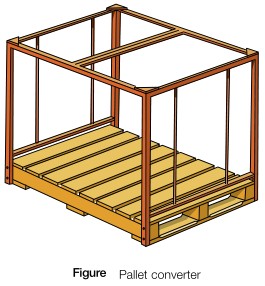
Racking systems
The term ‘racking’ is used to describe a skeletal framework, of fixed or adjustable design, to support loads generally without the use of shelves. It is usually qualified (ie pallet racking, tyre racking, drum racking, etc). Racking systems are widely used in warehouses as there are considerable space advantages over floor storage and they provide for easy access and retrieval of goods. There are many different types of racking system.
All racking systems should be of good mechanical construction, of sound material, adequate strength and installed and maintained in accordance with the manufacturer’s instructions. The maximum safe working load and design configuration for any racking installation should be conspicuously displayed.
Some common types of racking systems in warehouse are,
- Adjustable pallet racking: A system of upright frames connected by horizontal beams to provide pallet storage levels, which can be adjusted vertically. Each pallet storage position can be accessed individually
- Mobile racking: The racking is mounted on movable base frames running on rails, it can be power operated, manually operated or mechanically assisted
- Cantilever racking: Racking corporating cantilever arms, either fixed or adjustable
- Live storage racking: A live storage system provides a block of storage in depth, which has a rear or ‘loading face’ and a front or ‘picking face’. Goods are conveyed from the loading to the picking face either by gravity using an inclined surface or track or by horizontal powered conveyer such that tow aisles are necessary to service a block of storage, whatever the depth. This method of storage ensures that the first-in-first-out system operates and is suitable for pallets, boxes and containers etc, all of which have specific requirements within a live storage system
- Push back system: Live storage systems providing a block of storage in depth, where picking and loading are both done from the front face of the block. Goods are conveyed to and from the storage position either by gravity using an inclined surface or track or by horizontal powered conveyer such that only one aisle is necessary to service a block of storage. This method of storage ensures that a first-in-last-out system operates and is suitable for pallets only
- Drive through/ drive-in-racking: This system provides blocks of static storage where pallets are stored two or more deep. By driving into the storage lane, access is gained to pallets supported along their sides on beam rails cantilever from the frames.
- Drive-in-system: the lift truck drives into a lane and reverses out. Drive through: similar to drive in, but the truck may drive through the block from one aisle to another
Racking installation
The requirements for the safe installation of racking vary according to the type and size of the system, and the nature of the building or area for which it is intended. Safe working loads, heights, widths and equipment tolerances should be set by the designers and manufacturers of the total system. The basic principles for safe installation are as follows,
- Racking should only be installed by competent people in accordance with the manufacturer’s instructions
- Racking should be erected on sound, level floors, capable of withstanding the point loading at each base plate
- Where the racking design requires it to be secured to the building, only those building members that have been ‘proved’, by structural calculations, as able to resist the forces applied should be used. In such a case, the racking design should be compatible with the building layout
- Double-sided runs should be connected and spaced using suitable run spacers
- Where necessary, eg where lift trucks or other mechanical handling equipment are used, racking should be securely fixed to the floor
- Aisles should be wide enough to ensure that mechanical handling equipment can be easily maneuvered. Widths will depend very much on the type of equipment used, eg some require a 90° turn to load and offload, some remain parallel to the aisle and have forks at 90° to the direction of travel
- Beam connector locks should always securely fix the connectors at the ends of each beam, to prevent accidental uplift of beams, eg by lift truck
- Racking should have a clear unambiguous notice securely fixed to it, stating the maximum load together with any necessary specified load configurations
- The limitations indicated in the maximum load notice should never be exceeded. The weight of each palletised load should be established before a decision is made to store it in the racking. This is particularly important where different products are stored which may vary considerably in weight, or where a new line of product is brought into the warehouse for the first time. In some situations, it may not be necessary to establish the weight of each palletised load, if the racking system is designed and installed to meet the storage requirements of the heaviest palletised load in the company’s operation. Nevertheless, adopt a system to ensure that all palletised loads intended for storage in racking can be safely stored in accordance with the particular racking design and installation
- Racking should never be altered (eg by welding) nor components removed without first consulting the manufacturer. Before changing the position of adjustable components on racking (as supplied), establish the design limitations of the new configuration and, where necessary, amend the safe working load notice. Adjusting the position of the first or second beam from the bottom is normally the most critical alteration, which always requires a check on the rated carrying capacity of the rack
- High visibility colours for key components of the racking, eg horizontal beams, will assist truck operators to correctly position the forks and avoid damage to the racking
Pallet stops
Using pallet stops attached to racking structures may increase the risk of structural damage from the load or thrust that may be applied to the racking. If racking layouts are correctly designed to give adequate clearances between back-to-back pallets or loads, then pallet stops are unnecessary for a trained and competent driver to deposit a pallet correctly and safely.
Racking stability
The main factors that influence the stability of the racking installation are the height-to-depth ratio and whether it is fixed to the floor or other suitable parts of the building structure. Free-standing racks (ie not fixed to the floor) should not be used in areas where lift trucks, order pickers or other mechanical handling devices are used. Where racks are subject to imposed loads from the storage of product, plus horizontal loads from loading and unloading, the minimum requirements for floor fixings should be,
- floor fix all uprights adjacent to aisles and gangways, where the height/depth ratio does not exceed 6:1. In this case, the rack height should be assessed as the height to the top of the topmost beam. While the depth of the rack should be taken as the overall depth of the frame or in a back-to-back situation, it can be taken as the depth of the two frames plus the length of the run spacer, providing that these are located at not more than 2.5 m centres
- floor fix all uprights where the height/depth ratio exceeds 6:1 but does not exceed 10:1
- where ratios are greater than 10:1, the manufacturer should provide specific guidance.
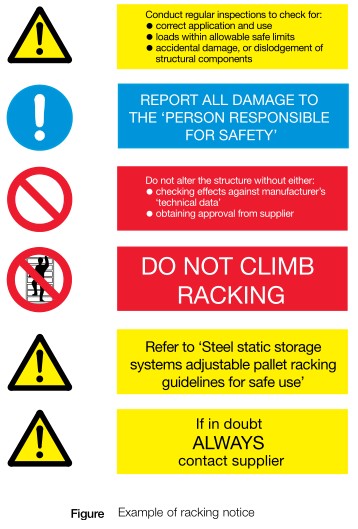
Racking protection
Where racking is likely to be struck by lift trucks and other vehicles, it should be protected. Generally, such damage is at the lower levels of the racking – use renewable column guards to minimise the risk of damage from accidental impact. Corner uprights in a run of racking are especially at risk and should be suitably provided with a protective device in a conspicuous colour. Retrofitting upright protection devices to an existing aisle where they have never been provided can have the effect of reducing the available clearances for fork-lift truck maneuvers, which can in some circumstances increase the amount of damage caused. Such situations need consideration on a case-by-case basis.
Placing or receiving stock from racking or shelving
Where it is necessary to place or retrieve stock from racking by hand, the following basic principles should be adopted,
- access to the racking or shelving should not be by climbing the racking or shelving
- where access equipment is to be used, this should be done safely
- mechanical handling plant should not operate in the proximity of workers who are engaged in such operations
Picking from in-rack walkways
Mezzanine floors can be provided between racking runs so that products can be picked or replenished at more than one level. This increases the picking locations in a given floor area where numerous operators can pick simultaneously. Typically, pallet racking is used where the replenishment side is fed by fork-lift truck and manual picking the other side. This can be single/double pallet depth or using live storage for greater capacity.
In addition to the general risks associated with working at height, care should be taken to ensure that workers are protected at picking locations:
- a shelf (timber or mesh) should be provided at the mezzanine level picking location to ensure that, when a pallet is not in a location, an operator cannot fall into the aperture created by the removal of a pallet
- there should also be a protective rail provided at the lower-level picking location to ensure that an operator cannot approach the open edge

